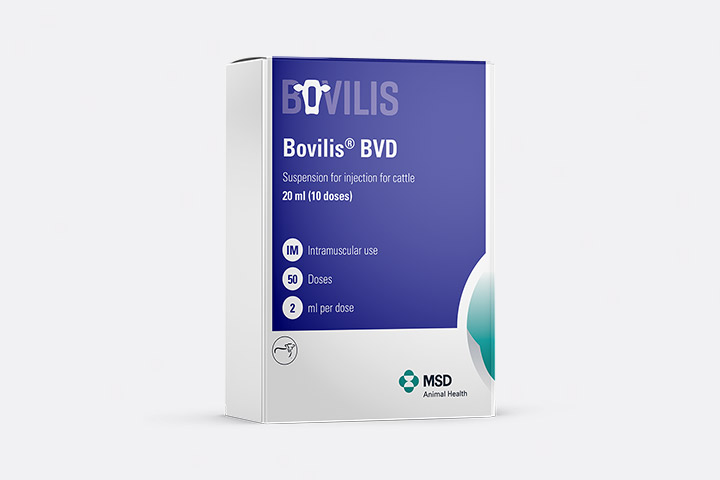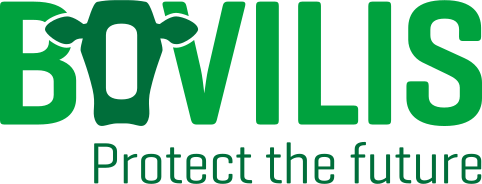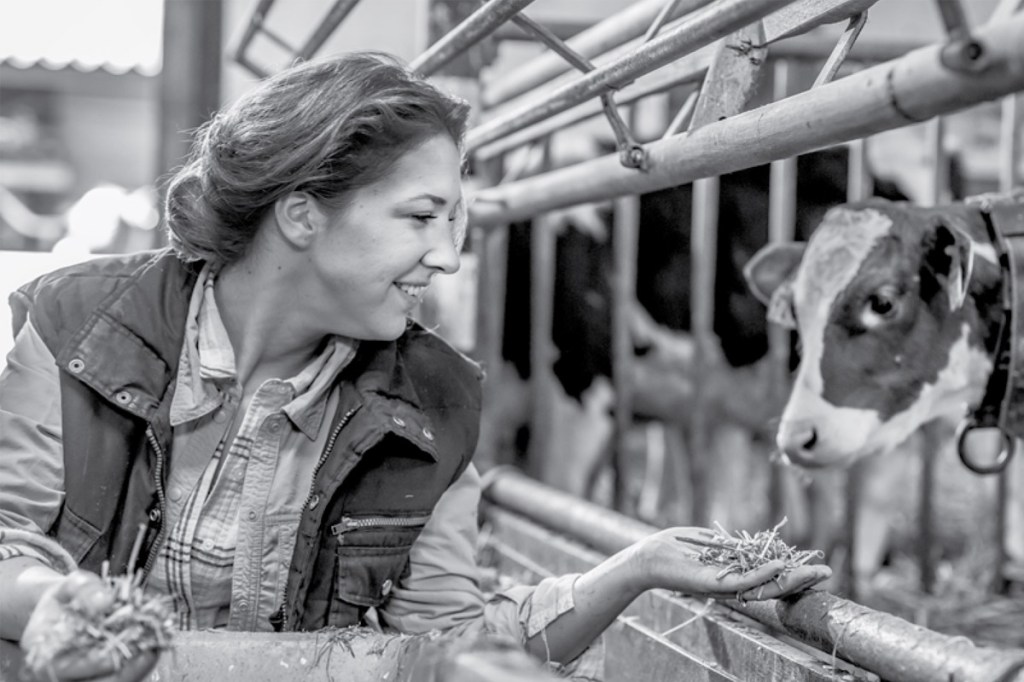

Bovine Viral
Diarrhea (BVD)
BVD is an highly infective disease that causes many
fertility problems and has a high economical impact
for the farm.
● BVD VIRUS TYPES ● CLINICAL SIGNS
● PERSISTENT INFECTED ANIMALS ● BVDV CONTROL PROGRAMS AND SURVEILLANCE
● COSTS AND BENEFITS OF PREVENTION AND CONTROL ● FINANCIAL IMPACT
Bovine Viral Diarrhea is a highly infectious disease caused by a virus transmitted by infected animals. Fertility problems are a sign of infection along with a low immune response. This low immunity makes infected animals vulnerable to all kinds of other diseases. If the dam is infected during pregnancy, she may give birth to a persistently infected (PI) calf that will spread high levels of the virus to other animals. The direct and indirect costs and production losses of BVD are high.1 To prevent BVD, it is important to know if you have PI animals on your farm. These animals should be removed. Herds can be protected through vaccination, regular monitoring and biosecurity measurements to prevent introduction of the circulating virus.
BVD virus types
BRD is a multifactorial disease of young and growing cattle. The factors that significantly predispose cattle to BRD include stress related to stocking, moving or mixing cattle, poor ventilation or draughts, sudden climatic changes or extreme heat or cold, mixing various age groups, nutritional deficiencies, colostrum deficiency, and poor feed hygiene. These stresses lead to infection by primary pathogens which cause lung damage and disease.
Clinical signs
The Bovine Viral Diarrhoea virus (BVDV) is a pesti virus that is endemic in cattle populations worldwide and results in substantial losses to the dairy and beef industries.2 The virus can cause various types of disease in the animals. There are two major genotypes of BVDV; BVDV Type 1 and BVDV Type 2. The most important effect is that it can cause infertility and abortions, affect the unborn calf and lead to mucosal disease (MD).
- Pyrexia
- Depression
- Anorexia
- Diarrhea
- Respiratory signs, which include nasal discharge and coughing
- Leukopenia with lymphopenia
Persistent infected animals
The main risk of infection comes from persistently infected (PI) cattle. If a naive non-infected cow is infected in her first 110 days of gestation, the calf may be born persistently infected (PI). The dam of a PI calf may test negative and this is important to consider when buying pregnant heifers/cows (Troyan cow). This PI calf is immune-tolerant to BVDV and thus has no antibodies against the virus and it can shed large quantities of virus throughout its life.3 PI animals may go undetected for several years and if PI heifers are bred they will always give birth to PI calves. PI animals may develop a fatal mucosal disease (MD) with bloody diarrhoea, fever and mucosal lesions in the mouth, as well as ulcerations at the muzzle, the nose, the rim of the hoof and in the interdigital cleft. The animals usually die within 3 weeks. Animals that are infected with BVDV after birth are referred to as ‘transiently infected’ and these usually show no signs of disease and eliminate the virus within a few weeks.
BVDV control programs and surveillance
In many countries there are control programmes for BVDV. In some countries non-vaccination approaches have been implemented whereas in other countries there are programs including vaccination strategies.3 There are several vaccines available on the market but vaccination as a stand-alone measure has never been shown to improve the epidemiological situation.4 The key component of a control program is removal of PI animals, biosecurity and vaccination of all breeding animals with a vaccine that has been proven to be able to prevent the birth of PI calves (vaccines that include foetal protection in their claims).
A practical approach can be the use of an inactivated BVDV vaccine in combination with a test for antibodies against non-structural proteins (NS). The vaccine exhibits properties of a marker vaccine where animals usually remain seronegative after vaccination but develop NS specific antibodies after field virus infection. With this approach, a field virus infection with BVDV can be monitored by measurement of NS antibodies in blood or (bulk) milk samples, even in a vaccinated herd.
Costs and benefits of prevention and control
The substantial costs of BVD for the industry have been evaluated in numerous studies and countries. A systematic review including 44 studies in 15 countries over the last 30 years indicated that direct losses ranged from $0.50 to 688 US dollars (USD) per animal, and average direct losses per naive dairy cow were $25 higher than per beef cow.5
The costs of BVD in beef cow-calf herds are also high. The cost of a BVD outbreak in a Scottish commercial suckler herd with no immunity to the virus has been estimated at £37 per cow as a result of infertility and abortion alone.6 The costs of BVD were attributed to various reproductive losses (44%), PI heifers and cows (16%), PI calves (19%), abortions (9%), immunosuppression of calves (7%) and congenital defects/growth retardation (5%). These estimates did not include costs of treating disease conditions associated with or resulting from BVD infection, nor the losses associated with reduced growth rates and higher variable costs. Some farmers may treat for these ailments oblivious to the fact that the main cause of them is the BVD virus. Undetected BVD is a massive threat to the performance and financial viability of any herd.
Financial impact
It is clear that BVDV infection has huge financial implications and thereby eradication and control within a herd will result in benefits. A study of 3 herds where virus was actively circulating indicated lower rates of insemination per pregnancy, more than doubled conception rate in first service, lower calving to conception rates and overall higher conception rate.7 A stochastic model was designed to calculate the cost-effectiveness of biosecurity strategies for BVDV in cow-calf herds.Results indicated that importing pregnant animals and stockers increased the financial risk of BVDV. Strategic testing in combination with vaccination decreased the risk of high-cost outbreaks in most herds.
A preventive approach brings to animal health status, food quality and overall farm productivity.
Bovilis® cattle vaccines against Bovine Viral Diarrhea (BVD)

Bovilis® BVD
An inactivated BVD vaccine for cows and heifers to protect the foetus against transplacental infection with bovine viral diarrhoea virus (BVDV).
Go to your country website
References:
- Weldegebriel, H.T., Gunn, G. J., Scott, A.W. 2009
Weldegebriel, H.T., Gunn, G. J., Scott, A.W. 2009, Evaluation of producer and consumer benefits resulting from eradication of Bovine Viral Diarrhea (BVD) in Scotland, United Kingdom. Prev. Vet. Med. 88, 49–56. - Coria, M. F., and A. W. McClurkin. 1978
Coria, M. F., and A. W. McClurkin. 1978. Specific immune tolerance in an apparently healthy bull persistently infected with bovine viral diarrhea virus. J. Am. Vet. Med. Assoc. 172(4): 449-451. - Stahl, K., and S. Alenius. 2012
Stahl, K., and S. Alenius. 2012. BVDV control and eradication in Europe–an update. Jpn. J. Vet. Res. 60 Suppl:S31-S39. - Moennig, V., and P. Becher. 2015
Moennig, V., and P. Becher. 2015. Pestivirus control programs: how far have we come and where are we going? Anim Health Res. Rev. 16(1):83-87.
- Richter, V., K. Lebl, W. Baumgartner, W. Obritzhauser, A. Kasbohrer, and B. Pinior. 2017
Richter, V., K. Lebl, W. Baumgartner, W. Obritzhauser, A. Kasbohrer, and B. Pinior. 2017. A systematic worldwide review of the direct monetary losses in cattle due to bovine viral diarrhoea virus infection. Vet. J. 220:80-87. - Gunn, G. J., A. W. Stott, and R. W. Humphry. 2004
Gunn, G. J., A. W. Stott, and R. W. Humphry. 2004. Modelling and costing BVD outbreaks in beef herds. Vet. J. 167(2):143-149. - Smith, R. L., M. W. Sanderson, R. Jones, Y. N’Guessan, D. Renter, R. Larson, and B. J. White.
2014 Smith, R. L., M. W. Sanderson, R. Jones, Y. N’Guessan, D. Renter, R. Larson, and B. J. White. 2014. Economic risk analysis model for bovine viral diarrhea virus biosecurity in cow-calf herds. Prev. Vet. Med. 113(4):492-503.


